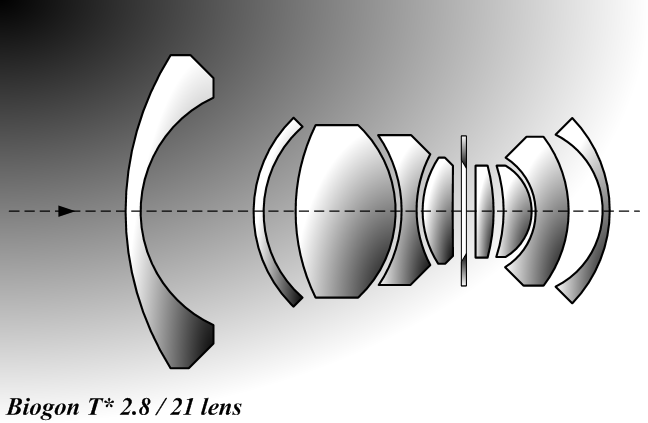|
Angénieux Retrofocus
The Angénieux retrofocus photographic lens is a wide-angle lens design that uses an inverted telephoto configuration. The popularity of this lens design made the name retrofocus synonymous with this type of lens. The Angénieux retrofocus for still cameras was introduced in France in 1950 by Pierre Angénieux. Inverted telephoto concept The telephoto lens configuration combines positive and negative lens groups with the negative at the rear, serving to magnify the image, which reduces the back focal distance of the lens (the distance between the back of the lens and the image plane) to a figure shorter than the focal length. This is for practical, not optical reasons, because it allows telephoto lenses to be made shorter and less cumbersome. The first practical telephoto lens was developed by Peter Barlow in the early 1800s, with the eponymous Barlow lens referring to the negative achromat inserted between the eye and a telescope. The inverted telephoto configuration does the ... [...More Info...] [...Related Items...] OR: [Wikipedia] [Google] [Baidu] |
Pierre Angénieux
Pierre Angénieux (; 14 July 1907 in Saint-Héand – 26 June 1998) was a French engineer and optician, one of the inventors of the modern zoom lenses, and famous for introducing the Angénieux retrofocus. Biography Angénieux graduated from the École Nationale Supérieure d'Arts et Métiers in 1928, and from the École Supérieure d'Optique the next year. He was a student of Henri Chrétien. After working for Pathé, Angénieux founded a company specialising in cinema equipment in 1935, ''Les Etablissements Pierre Angénieux''. He started using Geometric optics rather than Physical optics in the design of his lenses, as Carl Zeiss and Ernst Abbe did, and developed computing methods decreasing the time needed to design a lens by an order of magnitude. In 1950, Angénieux introduced the Angénieux retrofocus, which allowed mounting wide-angle lenses on Single-lens reflex cameras. In 1953, Angénieux designed the fastest lens of the time, reaching 0.95. The design was used in ... [...More Info...] [...Related Items...] OR: [Wikipedia] [Google] [Baidu] |
35mm Format
file:135film.jpg, 135 film. The film is wide. Each image is 24×36 mm in the most common "small film" format (sometimes called "double-frame" for its relationship to the "single-frame" 35 mm movie format or full frame after the introduction of 135 sized digital sensors; confusingly, "full frame" was also used to describe the Full frame (cinematography), full gate of the movie format half the size). file:LEI0060 186 Leica I Sn.5193 1927 Originalzustand Front-2 FS-15.jpg, Leica I, 1927, the first successful camera worldwide for 35 cine film 135 film, more popularly referred to as 35 mm film or 35 mm, is a Film format#Still photography film formats, format of photographic film with a film gauge of loaded into a standardized type of magazine (also referred to as a cassette or cartridge) for use in 135 film cameras. The term 135 was introduced by Kodak in 1934 as a designation for 35 mm film specifically for still photography, perforated with Film perforation ... [...More Info...] [...Related Items...] OR: [Wikipedia] [Google] [Baidu] |
Biogon
Biogon is the brand name of Carl Zeiss for a series of photographic camera lenses, first introduced in 1934. Biogons are typically wide-angle lenses. History ''Biogon'' (I), 1934 File:Bertele-Zeiss Biogon (1934).svg, Zeiss ''Biogon'' by Bertele (1934), from US 2,084,309 File:Bertele US2549159A (Aviotar, 1947).svg, Wild ''Aviotar'' by Bertele (1947), from US 2,549,159 File:Jupiter-12 (Contax-Kiev lens mount).JPG, KMZ ''Jupiter-12'' lens The first ''Biogon'' lens (2.8 / 3.5 cm, an asymmetric design featuring seven elements in four groups) was designed in 1934 by Ludwig Bertele while he was working for Zeiss, as a modification of his earlier '' Sonnar'' design (1929). The ''Biogon'' was assigned to Zeiss Ikon Dresden and marketed with the Contax rangefinder camera. It was produced by Carl Zeiss starting in approximately 1937, first in Jena, then a redesigned version was built in Oberkochen. Bertele would go on to reuse the design for the Wild ''Aviotar''. After Wor ... [...More Info...] [...Related Items...] OR: [Wikipedia] [Google] [Baidu] |

